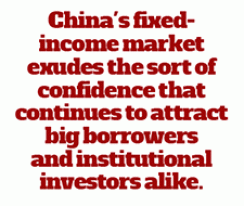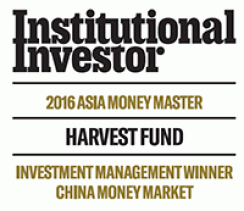To view a PDF of the report, click here.
China’s $10 trillion-plus fixed-income market could use Frank Sinatra’s “My Way” as its theme song.
The Asian giant's market for government, financial institution and corporate bonds, as well as asset-backed securities, has carved a unique path among the major world economies. Regulators have moved cautiously while opening the market in stages – for example, limiting foreign access to bonds through “qualified investor” programs, before lifting all restrictions last year. But this independent course, synthesized by Beijing’s oft-used expression “a market with Chinese characteristics,” has been paved with a few regrets.
The lifting of implied government protection for state-owned companies several years ago, for example, generated market panic. Concerns have also clouded the municipal bond market — which, owing mainly to development gaps between provinces, has been maturing slowly since
Beijing started letting local governments issue paper in 2014. Freestyle financing through wealth management products and shadow banking has stirred trouble for interbank-traded bonds issued by brokers and banks. In December, for example, regulators had to intervene in a dispute over allegedly faked documents and bonds worth $1.4 billion tied to a Shenzhen brokerage.
Nevertheless, China’s fixed-income market exudes the sort of confidence that continues to attract big borrowers and institutional investors alike.

Sharing that assurance, the People’s Bank of China (PBOC) last year awarded foreign institutional investors full access to the bond market for the first time. The central bank also gave select institutions permission to issue asset-backed securities — in limbo since the 2008–’09 financial crisis — to help them manage nonperforming loans, including mortgages. These moves fit with two PBOC objectives: to diversify risk and to let market forces play an increasingly stronger role in a credit infrastructure long dominated by government guarantees.
Chinese business is moving in the prescribed direction. A Standard Chartered Bank analysis found that bonds accounted for about 20 percent and standard loans about 70 percent of the nation’s credit market last year, compared with 5 percent and 75 percent, respectively, a decade earlier.
Hayden Briscoe, who heads the Fixed Income, Asia–Pacific unit at UBS, has noted that China’s all-important real estate market was buttressed in 2016 by fresh leveraging via new mortgage activity, as well as “healthy destocking” of unsold units. The market also profited from government infrastructure spending and rising revenues for heavy industry.
Critics of China’s approach to managing its fixed-income market point to last year's surge in capital outflow as a red flag. But supporters, led by the PBOC, view volatility as a sideshow in a market underpinned by solid risk control and prudent monetary policy, and benefiting from vigorous government spending and a rising consumer class. The nation’s campaign to shift from an export-based to a consumer-rooted economy bore fruit during the first three quarters of 2016, according to PBOC figures, as per capita disposable income rose nearly 8 percent among urban consumers, and total retail spending jumped 10 percent year-over-year.
And consumerism is just one reason China’s robust, if sometimes volatile, economy is giving institutional investors reason to sing along as the fixed-income market does it “My Way.”
“Safety First” Drives Harvest Fund’s Fixed-Income Success

Beijing-based Harvest Fund is a well-known pillar of the Asian investment industry, with 18 years of success in China’s emerging market and $138 billion in assets under management as of January 1.
Whenever the market swings south, Harvest Fund and its suite of fixed-income products draw more-than-usual investor attention. That’s exactly what happened last year amid China equities turmoil in the first quarter and bond market volatility in the fourth quarter.
Global investors took special note in January when the firm’s Harvest Money Market A Fund was awarded the Institutional Investor 2016 Asia Investment Management Award for China Money Market (Yuan). Harvest Fund serves the overseas community through offices in Hong Kong, London and New York, catering to sovereign wealth funds and firms with mainland holdings through China’s Qualified Foreign Institutional Investor program.
The winning product’s veteran manager, Wei Li, credits investment teamwork and a long-term strategy that puts liquidity management and risk management ahead of the hunt for yield. She has been managing the fund since 2009. The fund scored a 10-year, annualized return of 3.5 percent.
“Actually,” Wei told Institutional Investor during a recent interview in Beijing, “the return benefit comes third, behind liquidity management and risk management.”
Another powerful endorser of Harvest Fund’s strategy is the National Social Security Fund of China, a government colossus that has been investing through the firm since 2002. Harvest Fund is the largest asset manager for all of China's pension funds combined.
Fixed Income Chief Investment Officer Jing Lei, who joined Harvest Fund in 2013 after working at AIG and AIA for 19 years, says the pension investors are “prudent investors” that appreciate “the depth of our research, as well as the breadth of our investment strategies.”
Strategic breadth helps protect the pension system’s assets while satisfying the demand for the kinds of healthy returns needed to support China’s huge retiree population. To that end, Jing says, Harvest Fund has since its early days pursued an “All Weather, Multi-Strategies” investment approach. In recent years, in addition to the active management and passive management investment models, MOM and FOF have been added to the mix, and asset allocation capability has been greatly deepened.
The strategy’s noteworthy results include annualized yields of 9.5 percent and 8.51 percent, respectively, for the Harvest Credit Bond Fund and the Enhanced Return Fixed Term Bond Fund, over the past three years.
Jing says the success of these and similar products reflects Harvest Fund’s ongoing effort to “strengthen fixed-income capabilities” by recruiting talented investment expertise, building a multi-strategies platform (“not just a niche”) to meet the investors’ demands, and deepening and expanding internal analytic capabilities. These capabilities helped the firm weather the market’s 2016 storms.
Wei admits the year-end bond downturn “was an extreme challenge” for the fixed-income team, and the industry overall. Harvest Fund, however, dodged the bullet. Risk control steps and asset allocation implemented before the storm kept portfolios safe. “Among all of Harvest’s products,” Wei says, “we were farthest from the negative deviation regulation bottom line.”
In fact, Wei explains, these volatile periods highlighted Harvest Fund’s advantages. “It was actually a good opportunity to show which fund company was capable of managing risk control well,” she says. “We’re confident we’re the best in the industry.”

| Harvest Fund Offers Credit Rating, Too Harvest Fund’s fixed-income service includes an in-house credit rating system that protects bond investors who may be unfamiliar with the China landscape.
|





